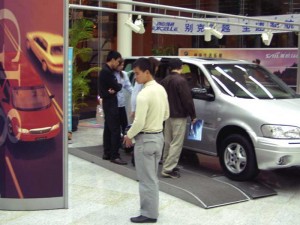It’s the largest and fastest-growing automotive market in the world, and it’s about to see the products that could push demand to still more records in the coming years. But a new study raises some serious concerns about the health of the Chinese auto industry.
Changing economic conditions, heavy-handed government policies – as increased competition – are all taking blame for a sharp decline in profitability among Chinese dealers, warns J.D. Power and Associates, which notes that’s just one of several worrying signs.
“These profit findings are troubling to more than just dealers,” said Charles Mills, vice president, global retail experience at J.D. Power and Associates. “Brands need dealers to continue to invest to meet their market potentials, and China customers increasingly expect more from their dealership experiences. This puts brands with lower dealer profitability at a disadvantage relative to competitors.”
According to Power’s 2012 China Dealer Attitude Study, the number of dealers reporting they were profitable for all of 2011 fell to 63%, down from 81% the year before. And during the same period the number of dealers operating in the red rose from 9% to 20%.
The downturn might surprise those who saw the Chinese car market continue to surge even during the worst years of what was otherwise a global automotive recession. But strong double digit sales have plunged sharply this year, the overall market for the so-called Middle Kingdom rising just 2% during the first quarter.
Virtually all segments of the market have been impacted, a recent report by Deutsche Bank revealing that manufacturers are cutting prices to respond to lagging demand – and increased competition – even in the luxury segment. Mercedes-Benz slashed as much as 25% off the sticker of some S-Class models earlier this year, though the cuts were significant less among most other luxury brands, said DB analysts.
But with fuel prices in China surging – and now running as much as 20% above what American motorists are paying – its lower-end segments feeling the pinch more sharply, according to LMC Automotive, which recently took over forecasting operations for J.D. Power.
Sales actually declined by 5% during the first quarter in the entry-level market, said LMC’s China analyst John Zeng. Minicars posted a 30% decline.
That has generated a surge in incentives which, in turn, mean lower transaction prices. And that cuts into dealer profitability.
For the year as a whole, LMC Automotive expects the Chinese new car market to grow by about 9%, “a much lower rate than in previous years when China’s new-vehicle sales surged at double-digit rates,” it predicted. But the situation is anticipated to improve going forward, with the firm forecasting a compound 12.4% growth rate through mid-decade, total Chinese sales expected to reach 20.9 million by 2014.
Other analysts, such as IHS Automotive, have pegged demand reaching as much as 30 million by decade’s end.
That’s appealing enough to keep the spigot open as manufacturers from around the world continue to invest heavily in the Chinese market. Ford, for one, announced plans to spend $760 million to double its product capacity by mid-decade.
But LMC analysts stress that the competitive situation is only getting more intense. There are now 94 brands in the Chinese market selling 476 different models, it noted, 40 brands and about 100 models more than in the U.S.

